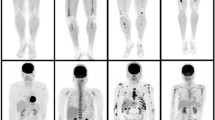Abstract
Identification of patient sub-groups with smoldering multiple myeloma (SMM) at high risk of progression to active disease (MM) is an important goal. 18F-FDG PET/CT (positron emission tomography (PET) integrated with computed tomography (PET/CT) using glucose labelled with the positron-emitting radionuclide 18F) allows for assessing early skeletal involvement. Identification of osteolytic lesions by this technique has recently been incorporated into the updated International Myeloma Working Group criteria for MM diagnosis. However, no data are available regarding the impact of focal lesions (FLs) without underlying osteolysis on time to progression (TTP) to MM. We hence prospectively studied a cohort of 120 SMM patients with PET/CT. PET/CT was positive in 16% of patients (1 FL: 8, 2 FLs: 3, >3 FLs: 6, diffuse bone marrow involvement: 2). With a median follow-up of 2.2 years, 38% of patients progressed to MM, in a median time of 4 years, including 21% with skeletal involvement. The risk of progression of those with positive PET/CT was 3.00 (95% confidence interval 1.58–5.69, P=0.001), with a median TTP of 1.1 versus 4.5 years for PET/CT-negative patients. The probability of progression within 2 years was 58% for positive versus 33% for negative patients. In conclusion, PET/CT positivity significantly increased the risk of progression of SMM to MM. PET/CT could become a new tool to define high-risk SMM.
This is a preview of subscription content, access via your institution
Access options
Subscribe to this journal
Receive 12 print issues and online access
$259.00 per year
only $21.58 per issue
Buy this article
- Purchase on Springer Link
- Instant access to full article PDF
Prices may be subject to local taxes which are calculated during checkout

Similar content being viewed by others
References
Kyle RA, Remstein ED, Therneau TM, Dispenzieri A, Kurtin PJ, Hodnefield JM et al. Clinical course and prognosis of smoldering (asymptomatic) multiple myeloma. N Engl J Med 2007; 356: 2582–2590.
Rajkumar V, Landgren O, Mateos MV . Smoldering multiple myeloma. Blood 2015; 125: 3059–3075.
Zamagni E, Patriarca F, Nanni C, Zannetti B, Englaro E, Pezzi A et al. Prognostic relevance of 18-F FDG PET/CT in newly diagnosed multiple myeloma patients treated with up-front autologous transplantation. Blood 2011; 118: 5989–5995.
Bartel TB, Haessler J, Brown TLY, Shaughnessy JD Jr, van Rhee F, Anaissie E et al. F18-fluorodeoxyglucose positron emission tomography in the context of other imaging techniques and prognostic factors in multiple myeloma. Blood 2009; 114: 2068–2076.
Usmani SZ, Mitchell A, Waheed S, Crowley J, Hoering A, Petty N et al. Prognostic implications of serial 18-fluoro-deoxyglucose emission tomography in multiple myeloma treated with total therapy 3. Blood 2013; 212: 1819–1823.
Waheed S, Mitchell A, Usmani S, Epstein J, Yaccoby S, Nair B et al. Standard and novel imaging methods for multiple myeloma: correlates with prognostic laboratory variables including gene expression profiling data. Haematologica 2013; 98: 71–78.
Zamagni E, Cavo M . The role of imaging techniques in the management of multiple myeloma. Br J Haematol 2012; 159: 499–513.
Rajkumar SV, Dimopoulos MA, Palumbo A, Blade J, Merlini G, Mateos MV et al. International Myeloma Working Group updated criteria for the diagnosis of multiple myeloma. Lancet Oncol 2014; 15: 538–548.
Boellaard R, Delgado-Bolton R, Oyen WJ, Giammarile F, Tatsch K, Eschner W et al. FDG PET/CT EANM procedure guidelines for tumour imaging: version 2.0. Eur J Nucl Med Mol Imaging 2015; 42: 328–354.
Moulopoulos LA, Varma DG, Dimopoulos MA, Leeds NE, Kim EE, Johnston DA et al. Multiple myeloma: spinal MR imaging in patients with untreated newly diagnosed disease. Radiology 1992; 185: 833–840.
Bäuerle T, Hillengass J, Fechtner K, Zechmann CM, Grenacher L, Moehler TM et al. Multiple myeloma and monoclonal gammopathy of undetermined significance: importance of whole-body versus spinal MR imaging. Radiology 2009; 252: 477–485.
Durie BG, Harousseau JL, Miguel JS, Bladé J, Barlogie B, Anderson K et al. International uniform response criteria for multiple myeloma. Leukemia 2006; 20: 1467–1473.
Hayes AF, Krippendorff K . ‘Answering the call for a standard reliability measure for coding data. Commun Method Meas 2007; 1: 77–89.
Kyle RA, Larson DR, Therneau TM, Dispenzieri A, Melton LJ 3rd, Benson JT et al. Clinical course of light-chain smoldering multiple myeloma (idiopathic Bence Jones proteinuria): a retrospective cohort study. Lancet Haematol 2014; 1: e28–e36.
Rosinol L, Bladè J, Esteve J, Aymerich M, Rozman M, Montoto S et al. Smoldering multiple myeloma: natural history and recognition of an evolving type. Br J Hematol 2003; 123: 631–636.
Larsen JT, Kumar SK, Dispenzieri A, Kyle RA, Katzmann JA, Rajkumar SV . Serum free light chain ratio as a biomarker for high-risk smoldering multiple myeloma. Leukemia 2013; 27: 941–946.
Perez-Persona E, Viridales MB, Mateo G, Garcia-Sanz R, Mateos MV, De Coca AG et al. New criteria to identify risk of progression in monoclonal gammopathy of uncertain significance and smoldering multiple myeloma based on multiparameter flow cytometry analysis of bone marrow plasma cells. Blood 2007; 110: 2586–2592.
Paiva B, Gutiérrez NC, Chen X, Vídriales MB, Montalbán MÁ, Rosiñol L et al. GEM (Grupo Español de Mieloma)/PETHEMA (Programa para el Estudio de la Terapéutica en Hemopatías Malignas) cooperative. Clinical significance of CD81 expression by clonal plasma cells in high-risk smoldering and symptomatic multiple myeloma patients. Leukemia 2012; 26: 1862–1869.
Bianchi G, Kyle RA, Larson DR, Witzig TE, Kumar S, Dispenzieri A et al. High levels of peripheral blood circulating plasma cells as a specific risk factor for progression of smoldering multiple myeloma. Leukemia 2013; 27: 680–685.
Rajkumar SV, Gupta V, Fonseca R, Dispenzieri A, Gonsalves WI, Larson D et al. Impact of primary molecular cytogenetic abnormalities and risk of progression in smoldering multiple myeloma. Leukemia 2013; 27: 1738–1744.
Neben K, Jauch A, Hielscher T, Hillengass J, Lehners N, Seckinger A et al. Progression in smoldering myeloma is independently determined by the chromosomal abnormalities del(17p), t(4,14), gain (1q), hyperdiploidy and tumor load. J Clin Oncol 2013; 31: 4325–4332.
Dhodapkar MV, Sexton R, Waheed S, Usmani S, Papanikolaou X, Nair B et al. Clinical, genomic, and imaging predictors of myeloma progression from asymptomatic monoclonal gammopathies (SWOG S0120). Blood 2014; 123: 78–85.
Hillengass J, Fechtner K, Weber MA, Bäuerle T, Ayyaz S, Heiss C et al. Prognostic significance of focal lesions in whole-body magnetic resonance imaging in patients with asymptomatic multiple myeloma. J Clin Oncol 2010; 28: 1606–1610.
Merz M, Hielscher T, Wagner B, Sauer S, Shah S, Raab MS et al. Predictive value of longitudinal whole-body magnetic resonance imaging in patients with smoldering multiple myeloma. Leukemia 2014; 28: 1902–1908.
Mateos MV, Hernández MT, Giraldo P, de la Rubia J, de Arriba F, López Corral L et al. Lenalidomide plus dexamethasone for high-risk smoldering multiple myeloma. N Engl J Med 2013; 369: 438–447.
Dykstra BL, Kumar S, Dispenzieri A, Lacy MQ, Buadi F, Dingli D et al. PET/CT has major diagnostic value in the evaluation of smoldering multiple myeloma. Blood 2014; 124: 3382 Abstract.
Ahn IE, Mailankody S, Korde N, Landgren O . Dilemmas in treating smoldering multiple myeloma. J Clin Oncol 2015; 33: 115–123.
Kastritis E, Moulopoulos LA, Terpos E, Koutoulidis V, Dimopoulos MA . The prognostic importance of the presence of more than one focal lesion in spine MRI of patients with asymptomatic (smoldering) multiple myeloma. Leukemia 2014; 28: 2402–2403.
Dimopoulos MA, Hillengass J, Usmani S, Zamagni E, Lentzsch S, Davies FE et al. Role of magnetic resonance imaging in the management of patients with multiple myeloma: a consensus statement. J Clin Oncol 2015; 33: 657–664.
Zamagni E, Nanni C, Patriarca F, Englaro E, Castellucci P, Geatti O et al. A prospective comparison of 18F-Fluorodeoxyglucose positron emission tomography-computed tomography, magnetic resonance imaging of the spine and pelvis and whole-body planar radiographs in the imaging assessment of bone disease in newly diagnosed multiple myeloma. Haematologica 2007; 92: 50–55.
Rajkumar SV, Larson D, Kyle RA . Diagnosis of smoldering multiple myeloma. N Engl J Med 2011; 365: 474–475.
Nanni C, Zamagni E, Versari A, Chauvie S, Bianchi A, Rensi M et al. Italian interpretation criteria for FDG PET/CT in multiple myeloma (MM). Eur J Nucl Med Mol Imaging 2015; e-pub ahead of print 16 October 2015.
Ghobrial IM, Landgren O . How I treat smoldering myeloma. Blood 2014; 124: 3380–3388.
Kristinsson SY, Holmberg E, Blimark C . Treatment for high-risk smoldering myeloma. N Engl J Med 2013; 369: 1762–1763.
Acknowledgements
The study was partly supported by the Fondazione del Monte of Bologna and Ravenna by a research grant to EZ.
Author information
Authors and Affiliations
Corresponding author
Ethics declarations
Competing interests
The authors declare no conflict of interest.
Rights and permissions
About this article
Cite this article
Zamagni, E., Nanni, C., Gay, F. et al. 18F-FDG PET/CT focal, but not osteolytic, lesions predict the progression of smoldering myeloma to active disease. Leukemia 30, 417–422 (2016). https://doi.org/10.1038/leu.2015.291
Received:
Revised:
Accepted:
Published:
Issue Date:
DOI: https://doi.org/10.1038/leu.2015.291
This article is cited by
-
Application of an artificial intelligence-based tool in [18F]FDG PET/CT for the assessment of bone marrow involvement in multiple myeloma
European Journal of Nuclear Medicine and Molecular Imaging (2023)
-
Hybrid simultaneous whole-body 2-[18F]FDG-PET/MRI imaging in newly diagnosed multiple myeloma: first diagnostic performance and clinical added value results
European Radiology (2023)
-
Smoldering multiple myeloma current treatment algorithms
Blood Cancer Journal (2022)
-
Positronen-Emissions-Tomographie/Computertomographie (PET/CT) beim multiplen Myelom
Der Radiologe (2022)
-
Role of FDG PET in the staging of multiple myeloma
Skeletal Radiology (2022)



